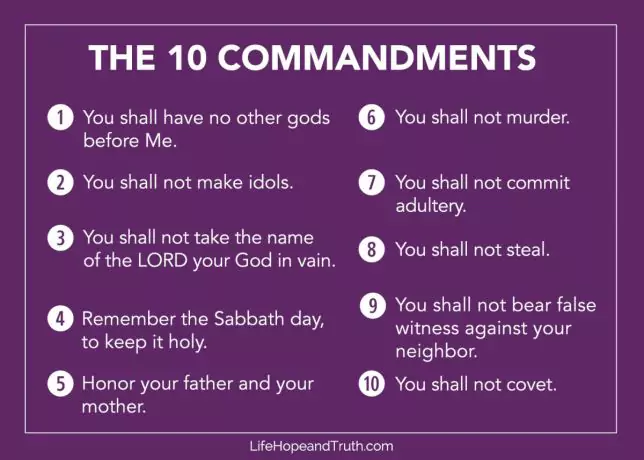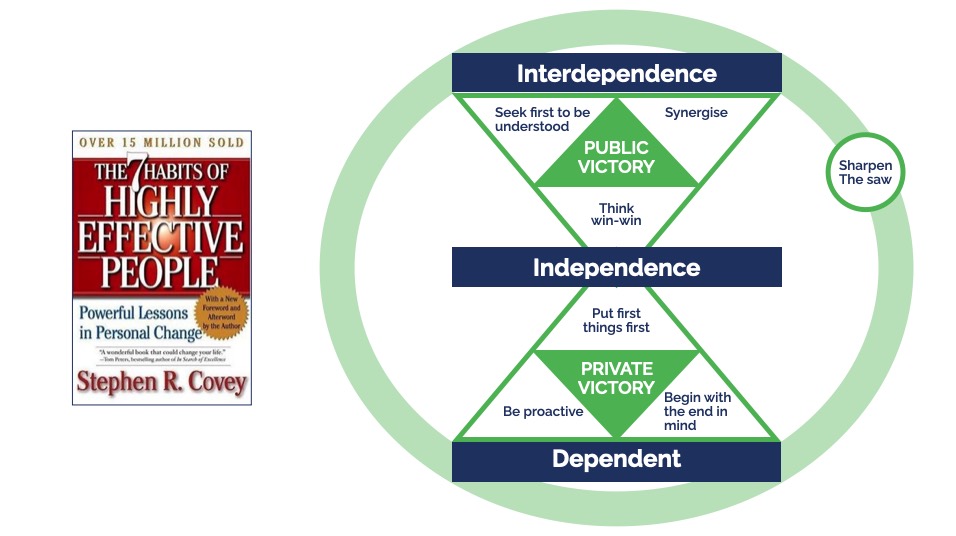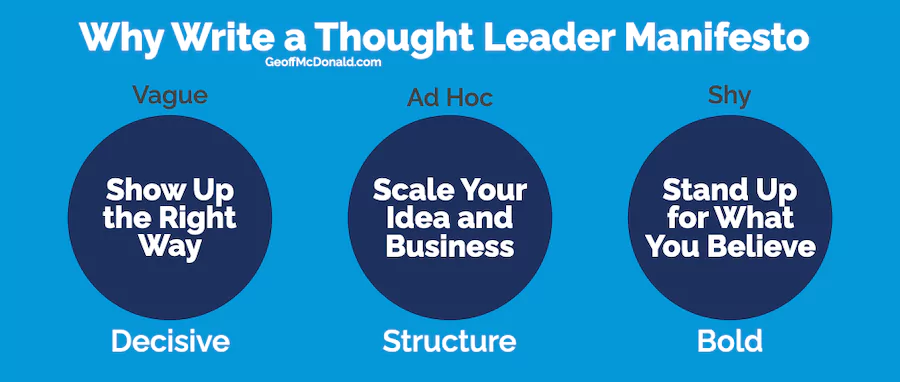The three big reasons to write a thought leader manifesto, answer the three big problems faced by business experts, consultants and professional service firms. How do you:
- Show up to potential clients as a solution to their problems?
- Scale your ideas and grow your business?
- Overcome the fear associated with sharing bold ideas?
The good news is that writing a thought leader manifesto can solve all three of these challenges.
The Content Creation Canvas Series
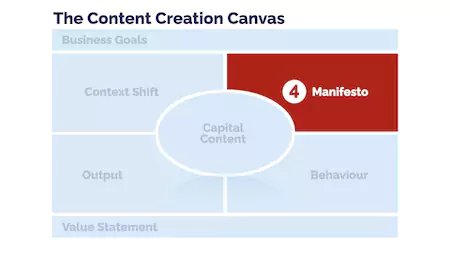
In our previous post, we talked about creating thought leadership solutions for your client’s problems.
That was part 3 of our seven-part series on the Content Creation Canvas – The Context Shift.
Today we’re translating this big picture Thought Leadership idea into a practical package that your clients want to buy.
It’s three big reasons to write a thought leader manifesto.
The Number One Marketing Problem You Face
The number one marketing problem that you face is showing up as a solution to your client’s problems.
If potential clients can’t see you as their solution, then they’re not buying from you, they’re buying from someone else.
Showing up is one thing, but you need to do it the right way.
If you ‘showed up’ by just standing on a street corner and tried to look cool, then you’re not likely to attract too many clients. Or worse, you’ll attract the wrong clients. That’s what happens when you show up in a vague way.
There’s an old saying in the world of sales: if you confuse, you lose. If you confuse your clients because you are too vague you will lose them to someone else.
It’s like someone visiting your website – if they don’t find what they’re looking for in the first 10 seconds then they’re clicking away from your site and heading to someone else’s. What’s worse, they’re not coming back.
The Right Ways to Show Up for Potential Clients
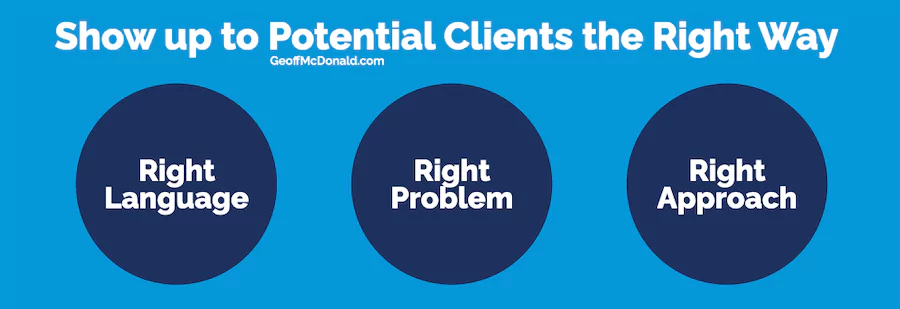
There are three things you must address here. (We’ve talked about two of them in previous posts, the third one we’re talking about in this post.)
- One, you need to speak in your clients’ language – more here.
- Two, you need to attract their attention by speaking to their problem – more here.
- And three, you need to show them your approach to solving their problem.
This is one of the three big reasons why you need a thought leader manifesto – to show your philosophy or approach to solving your client’s problems in a clear, consistent, and decisive way.
What is a Thought Leader Manifesto?
To begin we need to ask the basic question: What’s a manifesto?
A manifesto is a declaration of your intent. It’s a tool for decisive change. In my view, it’s an essential part of every thought leader’s toolkit.
Yes, some people, like the Unabomber who have hurt a lot of people have used manifestos, but so do artists, authors, and politicians.
A thought leader manifesto is a short sharp statement of your approach to solving your client’s problems.
It’s a plan for how your clients win. You might think of it as a strategy, a recipe, an instruction guide, a game plan or a winning formula.
It’s what you’d say and do if you had the same problem your clients have.
In its simplest form, a thought leader manifesto is a list. But it can also be expanded into chapters for a book or into other products and services, including your content marketing.
Here are three examples…
How do you live a good life?
How do you live a good life? We all ask that question at some point in our lives. But how do you answer that?
Most people only have vague answers. Typically, they have a shopping list of general themes that don’t promote consistent action.
What they’re missing is the right combination of a clearly defined context and clear actions. The previous post was all about defining your context.
This post is all about defining the rules or actions or principles that will have you win in this context.
The two parts of a Rule-Based Manifesto looks like this…
How to win as a Christian
While there are a few different versions of the Ten Commandments depending upon which Bible you’re reading the general backstory goes something like this.
Moses and a bunch of children were camping out at Mount Sinai. There was a bit of a storm with lightning and thunder and God came down to have a chat. After a couple of beers, or perhaps some bread and wine, God gave Moses a gift – a couple of stone tablets. And on those tablets were the ten commandments that were instructions or rules for how to live a good life in the eyes of the Christian God.
Those commandments include:
- Don’t take the name of your God in vain.
- Sunday is a holy day.
- Don’t go around killing people.
- No stealing and no adultery.
Can you see how clear, consistent and decisive this is?
Making it easy for clients to buy from you
If you were choosing to follow the Christian faith, you can use the ten commandments, the manifesto from the Bible, to decide if it is for you or not.
You might look at the ten rules and say, ‘Yep, I agree with that’ or ‘No, that’s not my cup of tea.’
When you have a decisive statement of your approach to solving your clients’ problems, you make it easy for them to be decisive about working with you.
You want potential clients to say, ‘I like your approach’.
In other words, I like your strategy, your philosophy, your manifesto.
What to Call Your Manifesto
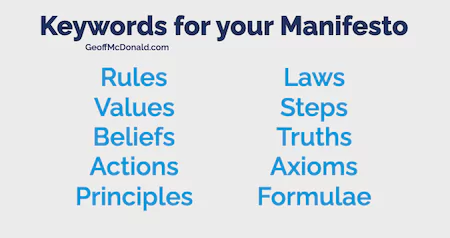
You don’t have to use Commandments in your manifesto. That might even send the wrong message.
Here are some other words you might use: Rules, Values, Beliefs, Actions, Principles, Laws, Steps, Truths, Axioms, Formulae
You choose what is best for you, they can all work. If you’re not sure, run it past your colleagues.
How do you create a worldwide business based on your ideas?
How do you create a worldwide business based on your ideas?
The big challenge for a lot of content creators, business experts and thought leaders is that they jump from one shiny object to the next.
- Work from home is a hot topic so let’s talk about that.
- Virtual teams is a big idea let’s talk about that.
- Or worse, a lot of people liked the one article you wrote about emotional capitalism, so you decide to switch your focus based on that response.
You’re bouncing around, being reactive and producing ad hoc solutions. This is a huge waste of your energy, attention and resources.
But wait, it gets worse.
This makes it impossible to attract your ideal clients because they don’t know who you are and what you stand for.
As an ideas guy, I’ve struggled with this a lot over my career – I’ve always been jumping onto the next big idea. It got so bad for me, whenever I met my friends their first question was always, ‘What are you working on now?’ With a big emphasis on the ‘now’. And usually, this came with a big eye-roll.
If my friends can’t keep up with me, what hope do potential clients have? Does this happen to you?
Giving Structure to your Ideas
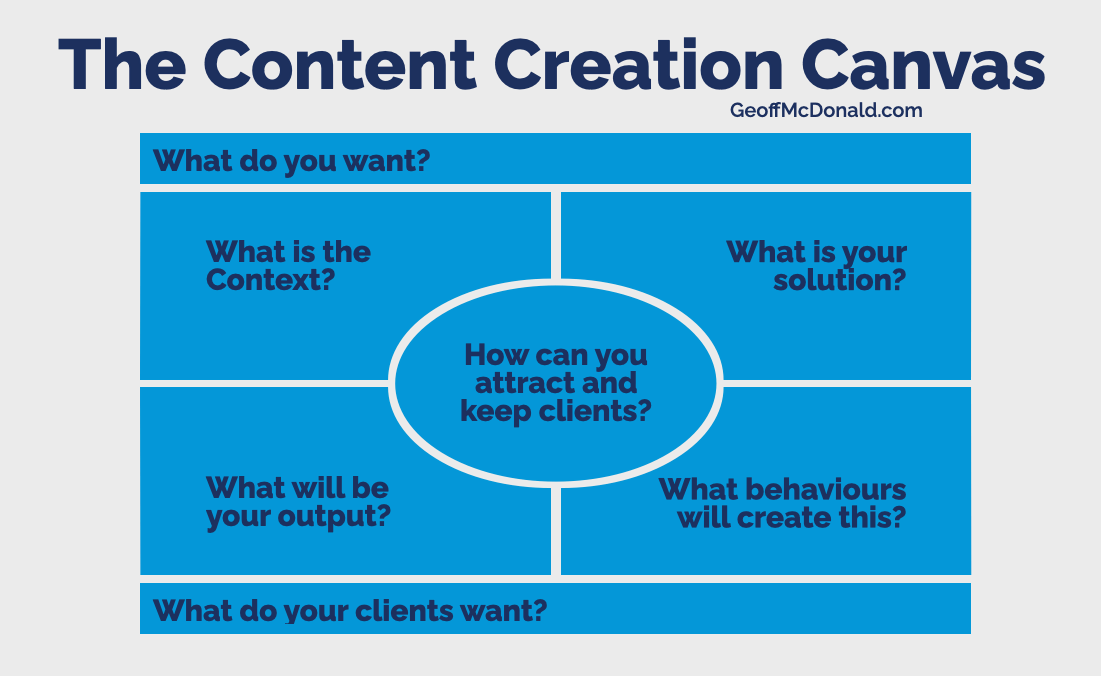
The underlying framework provides certainty, clarity and consistency.
It sends a strong signal even when the content shifts.
This post is a good example. I started by creating the Content Creation Canvas as a framework for what I do. It has seven parts which are the current series of posts and videos I’m making. This post is part four. Also, I was able to rework that as a manifesto in a further post. And I’m now coaching people using this framework.
That’s consistent and decisive content.
How Stephen Covey built a global business
When you have a foundation structure you can then leverage your ideas into multiple creative expressions.
A great example of this is the work of Stephen Covey, author of ‘The Seven Habits of Highly Effective People’.
- He wrote a seven-part manifesto.
- A visual model of his manifesto.
- And he turned this into a book that sold over 15 million copies worldwide.
- Then, he partnered with another company and turned this into a global training business worth millions of dollars.
Start with Your IP Creation
This is why I recommend you start with your IP Creation before you do any Content Marketing.
The frameworks from your IP will make it easier for you to create content because you’ll know what to talk about.
It will make it easier for your clients to follow along because of the consistent content you create.
Best of all, it will give you the foundation, the structure and the platform to scale your idea.
This is how you become a thought leader.
This is how you turn your single idea into a global business.
The Essential Personal Quality you need to be a Thought Leader
The third big reason you need a thought leader manifesto is to overcome your fear and concerns.
At various times, we all get scared, anxious and nervous – It’s part of being human.
Way back in caveman times, if you were on your own you were at a greater risk of dying. Alternatively, you were safer if you were part of a group.
This became hardwired into our thinking – being connected as part of a group is good. Not being part of the group is bad.
This is why so many of us are shy when it comes to sharing our ideas. It makes earning money from your ideas a risky business – one crazy idea and you might get voted off the island.
I know what this feels like every time I hit publish on these posts and videos. The same thought goes through my head – what will people think?
But there is a way around this by writing and using your manifesto.
The Great American Startup
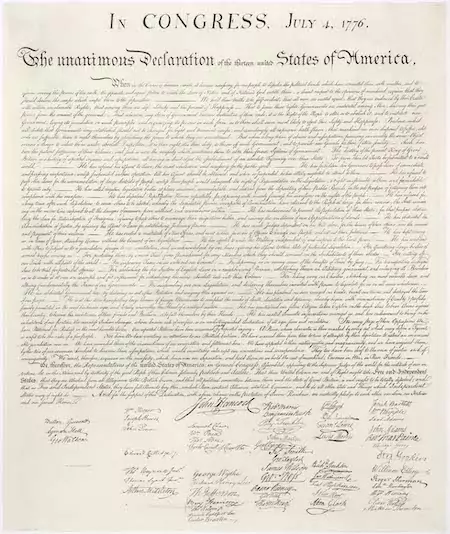
Their previous boss, George, was taking a lot of taxes out of their income and they didn’t like it.
They got together and said, we’re not going to put up with this anymore. You’re no longer our boss. Instead, we’re going out on our own to do it our way.
If you’ve ever quit your job to start a new business, then you can probably relate to this.
Except, in this case, their boss was King George III of England and by creating their own startup, they were committing treason. This meant they could be killed or imprisoned.
And just to make it worse, by going out on their own they started a war.
This was the birth of America. Those 56 guys signed the US Declaration of Independence – one of the world’s great manifestos.
Their startup idea was to declare the end of British rule and declare the birth of a new country.
You could say their manifesto was their MVP – Minimum Viable Product. It kicked things off but also started the US War of Independence.
Permission
To earn money from what you know is not for everyone. It’s a bold move. But at least in today’s world, you’re not likely to be charged with treason.
To help you further, one of the lines from the Declaration of Independence gives you the one thing you will need to pull this off.
One of the biggest personal challenges we all face when we’re being creative occurs when we start thinking about how other people might react to what we say and do.
This makes us want to get it right and avoid being wrong. And this makes us shy when it comes to sharing our ideas.
But in Thought Leadership and in creating your manifesto there are no right answers. Instead, we simply need to provide a better context to work from.
To help you move from shy to bold, consider what those 54 men signing the US Declaration of Independence wrote the immortal words: “We hold these truths to be self-evident…”
What does this mean?
Essentially, it means we believe this to be true. They’re not saying, ‘this is the truth’. Instead, they are saying, ‘we believe this to be true.’ That’s a big difference.
We believe…
Your manifesto is simply what you believe to be true. It’s your point of view, your opinion and your belief.
And the good news… Some people will agree with you and others won’t.
You don’t have to please everyone. You just have to provide value and service to some of them.
Be bold.
Plus, the big bonus here is that you can sit down and plan your idea in advance. And as you develop your ideas you can test them with your colleagues before using them to attract new clients.
Creating Your Manifesto
To write your thought leader manifesto you need these two steps.
- First you need to define your context. Read our previous post to identify your Context Shift.
- Then write a list of the actions or principles or rules for winning in this context.
Share it with your colleagues and clients to refine it.
Then share it in everything you do to present a decisive, scalable and bold vision of your work.
Once you’ve done this, click on our next post in this series where you will convert the thought leadership IP you’ve created in this video into your Capital Content – the one set of content you need to create to both attract new clients and keep your existing ones.
Summary
The three big challenges every thought leader, business expert and professional service firm faces are to:
- Show up and be seen to attract your ideal clients
- Scale your ideas and grow your business
- Overcome your concerns and fear of what others will think about your ideas
By writing a thought leader manifesto you can overcome all three challenges because you:
- Have a clear, concise and decisive way to share your approach with potential clients
- Can scale your ideas because you have a consistent framework that can be applied to different creative expressions
- Know that your manifesto is what you believe and this only has to be true for you and valuable for your clients.
More on the Thought Leaders Strategy 2022
If you want to go deeper and follow this series on Thought Leadership Strategy 2022 and the Content Creation Canvas, here are the other posts in this series.
- Overview: Content Creation Canvas: Build thought leadership, attract new clients
- First in this series: Content Strategy 2022 – Best framework for Thought Leaders
- 2: Create your Killer Client Value Statement in Three Steps
- 3: How Thought Leaders earn money from what they know
Your Big Question
What does your manifesto say? And what format did you use – are they rules, principles or axioms?



